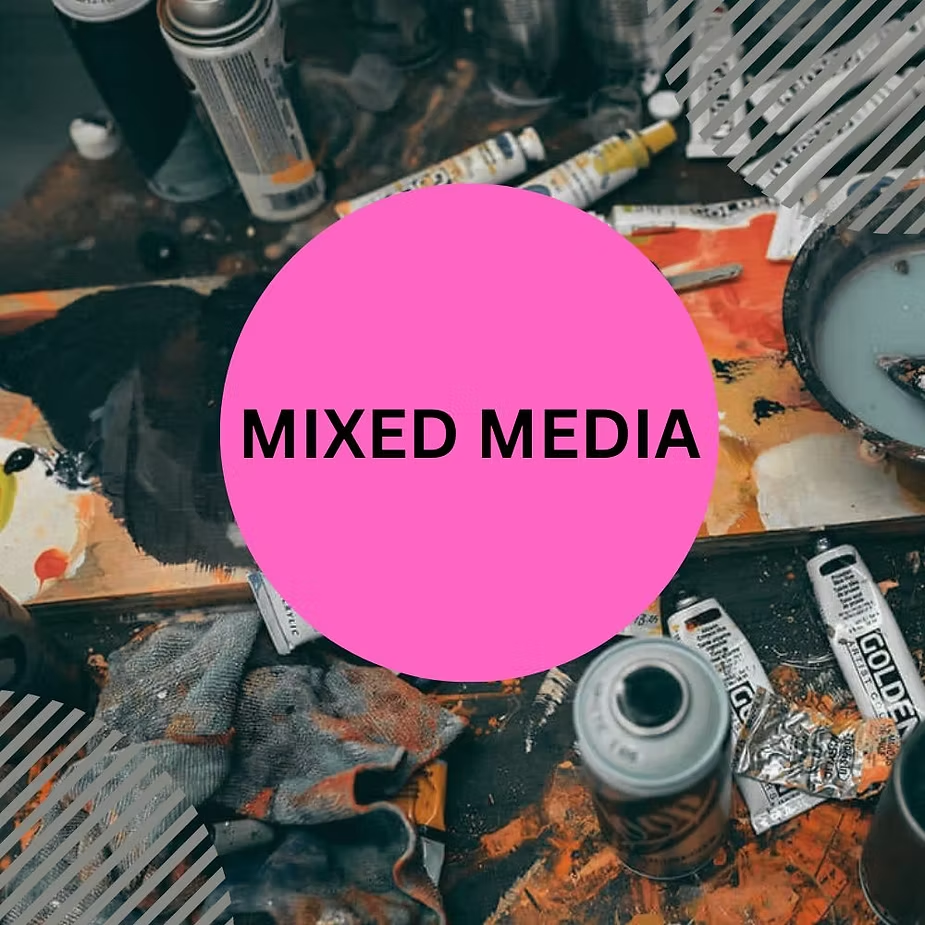Mixed media art serves as a dynamic platform for artists to amalgamate diverse materials and techniques, transcending traditional boundaries to create visually captivating and conceptually profound compositions. Tailored for seasoned art students seeking to expand their repertoire, this blog post delves into 8-10 sophisticated mixed media techniques, offering scholarly elucidations, comprehensive material lists, and nuanced practice topics for each technique.
1. Collage Mastery
Collage transcends mere juxtaposition, evolving into a complex interplay of textures, colors, and narratives. Art students adept in collage harness the synergy of disparate elements to construct cohesive yet multi-layered compositions.
Materials
• Assorted papers (e.g., archival, handmade)
• Acrylic gel medium or archival glue
• Precision cutting tools (X-Acto knife, precision scissors etc.)
Topics to Practice
• Construct a meta-narrative collage exploring the juxtaposition of personal and societal identities.
• Experiment with surrealist techniques, integrating unexpected elements to challenge conventional perceptions.
2. Fluid Dynamics in Acrylic Pouring
Acrylic pouring epitomizes the fluidity of artistic expression, wherein meticulous control converges with serendipitous chance, yielding mesmerizing patterns and ethereal gradients.
Materials
• High-quality acrylic paints with diverse viscosities
• Pouring mediums tailored for fluid art
• High-density canvases or cradled wood panels
Topics to Practice
• Investigate the interplay of color theory and fluid dynamics, orchestrating harmonious compositions through strategic color placement.
• Employ advanced pouring techniques, such as “swipe” or “flip and drag,” to imbue compositions with dynamic movement and textural depth.
3. Multifaceted Mixed Media Painting
Mixed media painting transcends conventional boundaries, melding traditional techniques with avant-garde materials to cultivate multifaceted visual narratives.
Materials:
• Versatile paints spanning acrylic, oil, and watercolor mediums
• Varied substrates accommodating diverse textures and compositions
• Found objects and unconventional mark-making tools
Topics to Practice
• Deconstruct the symbiotic relationship between form and content, employing mixed media elements to elucidate underlying thematic motifs.
• Challenge preconceptions of artistic hierarchy, seamlessly integrating digital elements within traditional painting frameworks.
4. Transcending Boundaries with Image Transfer
Image transfer epitomizes the fusion of digital and analog realms, facilitating seamless integration of photographic imagery into mixed media compositions, thereby transcending conventional boundaries of representation.
Materials:
• High-resolution laser prints or archival photocopies
• Transfer mediums tailored for diverse substrates
• Delicate brayers or rubber squeegees for precise transfer
Topics to Practice
• Interrogate the notion of memory and temporality, juxtaposing archival photographs with ephemeral textures to evoke a sense of nostalgia and transience.
• Exploit the malleability of digital imagery, deconstructing and reconstructing photographic narratives to subvert entrenched perceptions of reality.
5. Precision and Poise in Stenciling
Stenciling exemplifies the synthesis of precision and poise, as artists navigate intricate designs and negative space to imbue compositions with dynamic tension and visual intrigue.
Materials:
• Intricately crafted stencils, ranging from commercial templates to bespoke designs
• High-opacity paints or archival inks for crisp, delineated edges
• Fine-tipped brushes or airbrushing apparatus for meticulous application
Topics to Practice
• Deconstruct cultural iconography, utilizing stenciled motifs to critique and subvert hegemonic narratives of power and identity.
• Embark on a quest for spatial harmony, employing stenciling techniques to orchestrate dynamic interplays between positive and negative space within compositions.
6. Textural Embellishments with Modeling Paste
Explanation: Modeling paste serves as a conduit for tactile exploration, facilitating the creation of three-dimensional textures that transcend the confines of two-dimensional surfaces, inviting tactile engagement and sensory immersion.
Materials:
• High-density modeling paste with varying degrees of viscosity and granulation
• Sturdy palette knives or sculpting tools for precise application
• Found objects and unconventional mark-making implements for textural embellishment
Topics to Practice
• Engage in a tactile dialogue with materials, sculpting and manipulating modeling paste to evoke organic forms and geological strata within compositions.
• Explore the interplay of light and shadow, utilizing impasto techniques to imbue surfaces with dynamic relief and chiaroscuro effects.
7. Found Object Assemblage
Found object assemblage transcends the realm of mere composition, inviting artists to engage in a process of archaeological excavation and narrative reconstruction, as disparate elements coalesce to form cohesive yet enigmatic wholes.
Materials:
• Eclectic array of found objects, ranging from discarded ephemera to salvaged artifacts.
• Industrial-grade adhesives and fastening mechanisms for secure attachment
• Architectural substrates and armatures conducive to structural integrity and spatial exploration
Topics to Practice
• Embark on a journey of serendipitous discovery, allowing found objects to guide the creative process and imbue compositions with layers of historical resonance and personal narrative.
• Subvert established hierarchies of value and utility, recontextualizing everyday detritus as sacred relics and cultural artifacts within the pantheon of contemporary art.
8. Illuminating Nuances with Watercolor Resist
Watercolor resist embodies the delicate interplay between opacity and translucency, as artists manipulate the impermeability of masking agents to orchestrate luminous gradients and ethereal washes that defy conventional boundaries of representation.
Materials:
• Archival-grade watercolor paints renowned for their luminosity and permanence
• Precision masking fluids or wax resists for intricate detail work
• Cold-pressed watercolor papers or archival substrates conducive to fluid washes and nuanced textures
Topics to Practice
• Explore the liminal space between presence and absence, utilizing watercolor resist techniques to evoke ephemeral landscapes and spectral apparitions that hover on the threshold of perception.
• Engage in a process of visual alchemy, transmuting mundane substrates into ethereal realms suffused with the ineffable beauty of transient phenomena and fleeting moments.
Advanced mixed media techniques represent the apex of artistic innovation and exploration, offering art students a boundless playground where experimentation converges with technical mastery to forge compositions of unparalleled depth and complexity. By embracing the inherent fluidity and dynamism of mixed media art, students can transcend conventional boundaries, unlocking new realms of creative possibility and self-expression. So, let your imagination soar, and may your artistic journey be as exhilarating as it is enlightening!


